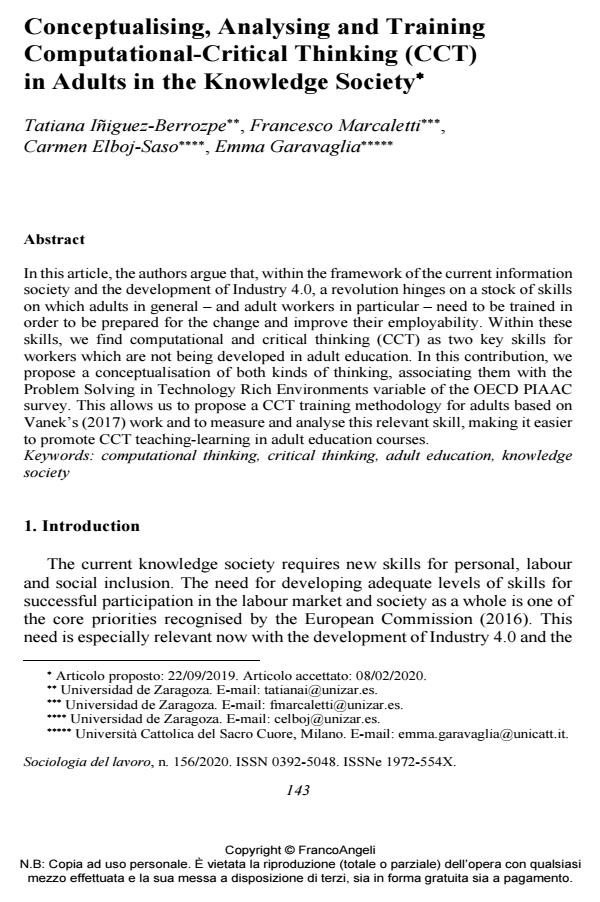Conceptualising, Analysing and Training in Adults in the Knowledge Society
Titolo Rivista SOCIOLOGIA DEL LAVORO
Autori/Curatori Tatiana Iñiguez-Berrozpe, Francesco Marcaletti, Carmen Elboj-Saso, Emma Garavaglia
Anno di pubblicazione 2020 Fascicolo 2020/156
Lingua Inglese Numero pagine 27 P. 143-169 Dimensione file 341 KB
DOI 10.3280/SL2020-156007
Il DOI è il codice a barre della proprietà intellettuale: per saperne di più
clicca qui
Qui sotto puoi vedere in anteprima la prima pagina di questo articolo.
Se questo articolo ti interessa, lo puoi acquistare (e scaricare in formato pdf) seguendo le facili indicazioni per acquistare il download credit. Acquista Download Credits per scaricare questo Articolo in formato PDF

FrancoAngeli è membro della Publishers International Linking Association, Inc (PILA)associazione indipendente e non profit per facilitare (attraverso i servizi tecnologici implementati da CrossRef.org) l’accesso degli studiosi ai contenuti digitali nelle pubblicazioni professionali e scientifiche
In this article, the authors argue that, within the framework of the current information society and the development of Industry 4.0, a revolution hinges on a stock of skills on which adults in general - and adult workers in particular - need to be trained in order to be prepared for the change and improve their employability. Within these skills, we find computational and critical thinking (CCT) as two key skills for workers which are not being developed in adult education. In this contribution, we propose a conceptualisation of both kinds of thinking, associating them with the Problem Solving in Technology Rich Environments variable of the OECD PIAAC survey. This allows us to propose a CCT training methodology for adults based on Vanek’s (2017) work and to measure and analyse this relevant skill, making it easier to promote CCT teaching-learning in adult education courses.
In questo articolo, gli autori sostengono che, nell’ambito dell’attuale società dell’informazione e dello sviluppo dell’Industria 4.0, è in atto una rivoluzione basata su stock di competenze a cui gli adulti in generale - e i lavoratori adulti in particolare - devono essere formati, al fine di essere preparati per il cambiamento e migliorare la loro occupabilità. All’interno di queste competenze troviamo la competenza computazionale e il pensiero critico (CCT) come due abilità chiave per i lavoratori che non sono sviluppate nell’educazione degli adulti. In questo contributo proponiamo una concettualizzazione di entrambe le competenze, associandole alla variabile Problem Solving in Technology Rich Environments dell’indagine OCSE PIAAC. Ciò ci consente di suggerire una metodologia di formazione CCT per gli adulti, basata sul lavoro di Vanek (2017), e di misurare e analizzare tale competenza, facilitando la promozione dell’insegnamento-apprendimento CCT nei corsi di educazione degli adulti.
Parole chiave:Pensiero computazionale, pensiero critico, educazione degli adulti, società della conoscenza
Tatiana Iñiguez-Berrozpe, Francesco Marcaletti, Carmen Elboj-Saso, Emma Garavaglia, Conceptualising, Analysing and Training in Adults in the Knowledge Society in "SOCIOLOGIA DEL LAVORO " 156/2020, pp 143-169, DOI: 10.3280/SL2020-156007